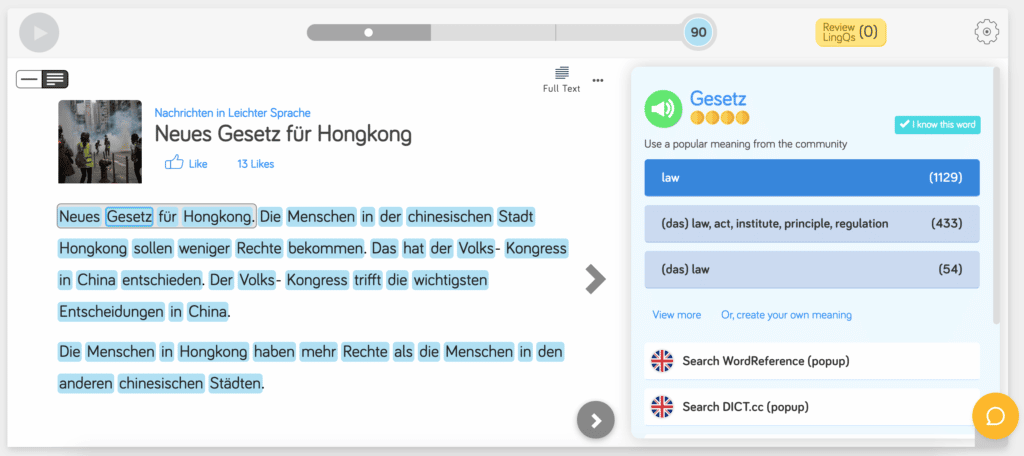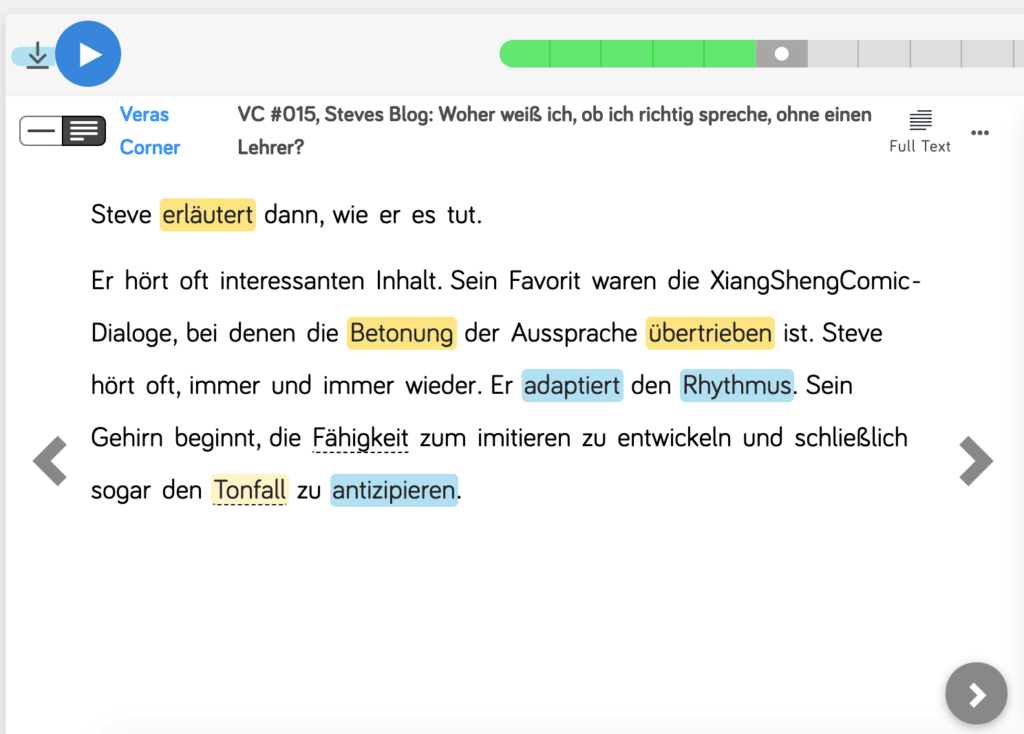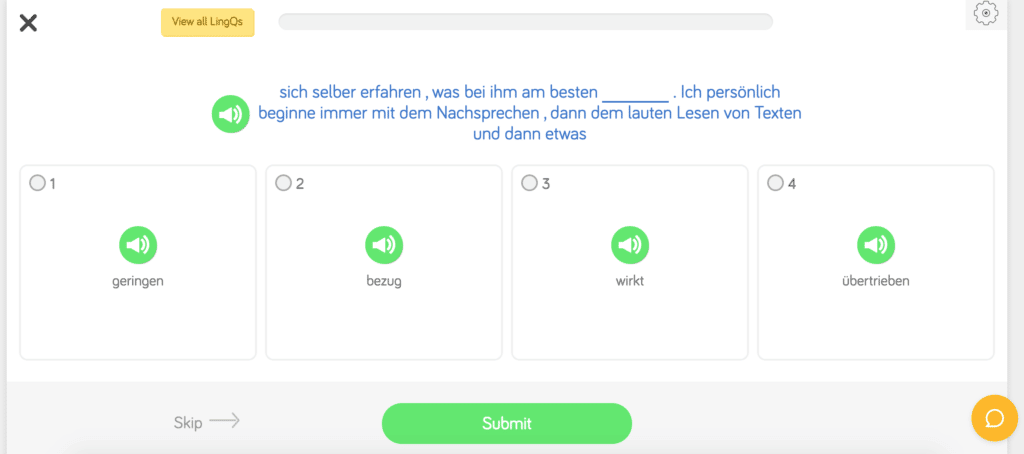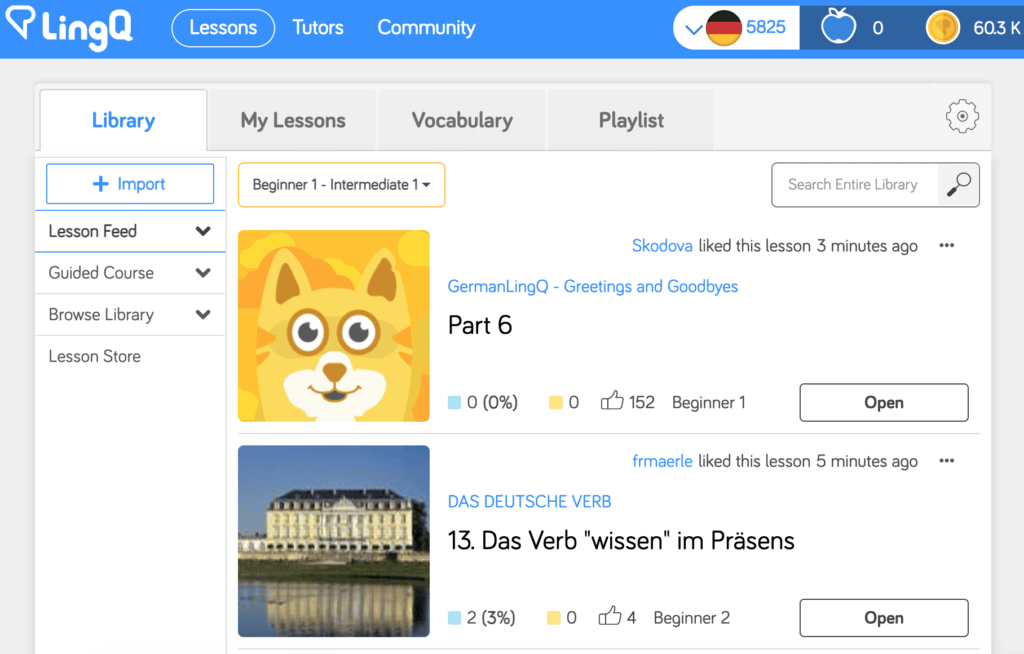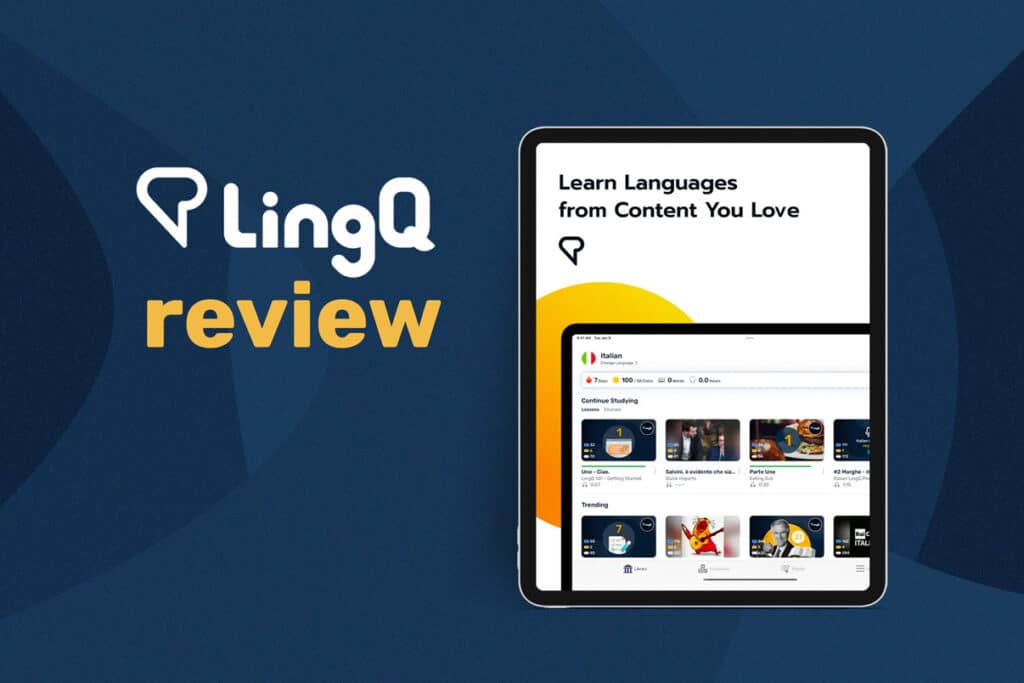
Complete 2024 LingQ Review: Abundant Authentic Content but Lacks Writing and Speaking Skills
LingQ turns real, authentic text and audio content into lessons for language learners.
Users upload news articles, blog posts, podcasts and practically any other written or audio content to LingQ, and the program works its magic to help you read it—and learn from it.
In this full unbiased and honest review, I take a close look at LingQ’s promises and whether the program delivers on them.
Overall, I loved the abundant authentic content (text and audio), but I was left underwhelmed by the program’s support for grammar, writing and speaking skills.
Contents
- The Theory Behind LingQ
- Key Features of LingQ
- The Pros of LingQ
- The Cons of LingQ
- LingQ Versus Other Language Learning Programs
- How Much Does LingQ Cost?
- The Final Verdict on LingQ
Download: This blog post is available as a convenient and portable PDF that you can take anywhere. Click here to get a copy. (Download)
The Theory Behind LingQ
LingQ (pronounced like “link”) was founded in 2007 by Steve Kaufmann, a well known Canadian polyglot.
LingQ focuses on authentic language content and comprehensible input, which is content that you can understand even if you don’t know every single word.
The idea behind LingQ is to become immersed in as much of the language as possible. As such, LingQ uses written and audio input as a basis for its lessons.
It’s designed to be a holistic language learning program, meaning that a learner can go from no knowledge to understanding and speaking the language with the program.
Key Features of LingQ
LingQ combines authentic language content and comprehensible input to deliver high-quality language learning material, but what does that actually mean on a practical level?
Let’s take a look at LingQ’s main features:
Authentic Native Text and Audio Materials
The crux of LingQ is its authentic language learning material. These materials come mainly in the form of written texts with accompanying audio and are entirely in whichever language you’re trying to learn, without any side-by-side English translations.
In fact, all the readings are written by native speakers. This forms the basis of LingQ’s digital immersion: You can access a huge library of native language content, most with recorded audio in your target language to go along with it.
You can slow down or speed up recordings to either aid or challenge your listening skills. Changing the playback speed can also make it easier for you to read along with the written content while the audio track is playing.
Interactive Interface and Flashcard Creation
LingQ does not just offer written and audio content, it also makes this content almost completely interactive.
That is because every word in a given reading is clickable. Simply choose any text and click on a word for an instant translation.
Once this word is looked up, it becomes a LingQ, which is an unknown word that will be tagged in future readings for recall and further study. These LingQs start off being highlighted in dark yellow, and as you see the word more and more, the shade of yellow lightens until the word is no longer highlighted at all. By then, hopefully you’ve learned it.
I found this fading out to be a neat visual way to show you how your learning is progressing. It is incredibly satisfying to watch the highlights go from a bright color to gradually fading away as I became more familiar with the words. I also found that this is a great way to understand just how well I knew a word.
Words that lose their highlight become “known words.” In fact, you can mark any given word as “known” by choosing it in the side panel or by simply not clicking on the word for a translation at all. Words that are not “known words” or LingQs yet are marked in blue.
I also loved watching my known word count climb with each lesson. Language learning should not be about how many words you know, but knowing that I could recall a certain number of words filled me with confidence.
Vocabulary that’s turned into LingQs is added to flashcard decks for later review. Review these decks to help a word eventually become “known.” Each word comes with a handy progress bar so that you know how well you can recall each word.
I found it amusing to try and clear all the blue from the lesson, by clicking on each word and either marking it as already known, or flagging it for later study.
Varied and Abundant Content
There is a huge amount of content available for language learners to choose from.
LingQ makes this content pretty easy to navigate by sorting it into different topics. These topics include business, sports, science, self-help and more.
Further, the content is divided into six levels, from Beginner 1 to Advanced 2.
Each lesson also has a percentage beside it. This percentage lets you know how many unknown words are in a given lesson. The lower the percentage, the easier it will be for you to follow along. LingQ puts higher percentages in red, signaling that the lesson contains many unknown words and may be hard to follow.
Since you can study anything that you want, I found it useful to see at a glance how challenging a lesson would be for me.
While a lot of the material is created or uploaded by LingQ users, every language has a couple of courses created by the LingQ program itself. These courses are generally catered toward complete beginners to help them get a basis in the language and get the hang of how the LingQ program works.
User Uploaded Content
One of the most unique features of LingQ is that it lets users upload their own content. This really drives home the idea that you can master a language using content they enjoy; if the program is missing something you want, just add it!
You can also upload text and accompanying audio, if you have it.
What can you import? Basically, anything that’s text- or audio-based. Among the content that you can import into the program are podcasts, YouTube videos, emails, social media posts, songs and their lyrics, e-books, news articles and more.
LingQ even has an extension that you can add to your browser or mobile device so you can easily transform any content you come across into a language learning lesson within the LingQ program.
The Pros of LingQ
Learning Through Authentic Content
One of LingQ’s main selling points—and perhaps its most attractive feature—is that it uses real written and audio content in your target language.
As previously mentioned, this content is written by native speakers and the accompanying audio is recorded by native speakers, as well. Authentic content is great for improving your accent, tuning your ears and understanding the language as it is actually used by native speakers. LingQ successfully uses it to create a digital immersion environment.
I found this quite refreshing in a language learning platform. Many other apps, courses or programs use a version of the target language that really isn’t used by real speakers of the language. This can cause communication mishaps down the road and seriously discourage learners. With LingQ, however, you learn from what native speakers actually read or listen to. In turn, it will be easier for you to understand and speak to native speakers of the language in real life later on.
Everything You Need in One Place
Whether you use LingQ through the website or through the app, everything you need can be found without leaving the program: written and audio material, a dictionary for translation, flashcards and progress trackers.
There is no need to leave LingQ for additional support, and that makes it a powerful learning tool. In my opinion, this is invaluable in a language learning program. There is nothing more tedious than having to have a dictionary and a flashcard creation tool nearby while trying to use a given resource.
Content for Every Level
A common drawback to many language learning apps is the narrow focus of their learning material. Many language programs focus heavily on beginner content, while intermediate and advanced topics can be hard to come by.
With LingQ, however, there is something for all learners, since six levels and virtually any topic imaginable is covered. In my experience, this kept me coming back to use the app, knowing that there was engaging content at every step of my language learning journey.
Further, user-created content is constantly being added. And if you are using the Premium subscription, then if something is missing, you can always add it yourself.
Stats and Data About Your Progress
If you are data-driven when it comes to language learning, LingQ is arguably the most comprehensive when it comes to tracking how many words you know in a language.
Its “known words” feature literally records every word that you already understand, and lingqs allow you to adequately track how many new words you are currently learning.
Further, in-depth statistics allow you to see how many lingqs you create in a day, how many words become “known” in a day and how well you know each word via a progress bar.
All this data gave the program a very game-like feel for me, and made it feel like I was gaining exp and leveling up my language skills as I learned.
The Cons of LingQ
Unfriendly User Interface
Despite the value it offers to language learners, LingQ is not without its faults.
One of the most obvious issues with LingQ is its interface. While it is not necessary to offer a high-quality, glossy interface like other language learning programs, it is hard to deny that LingQ looks basic.
In fact, the entire program is a little clunky and not at all visually appealing, especially in individual lessons. Its accompanying dictionary and in-program translation are particularly hard on the eyes. I found this interface especially rough in the LingQ app: with so many things crammed on the screen, it was hard to learn for extended periods of time.
No Grammar Instruction
While visual appeal can be overlooked, there are some shortfalls to LingQ that I don’t believe can be ignored. Namely, if you are looking for grammar instruction, LingQ does not offer that.
In fact, as a rule, LingQ adheres to the philosophy that grammar should not even be explicitly learned; rather, learners should “acquire” grammar as they are immersed in the language. Not all language learners study according to this philosophy—myself included—so it can be frustrating when you don’t understand a certain sentence structure or grammatical feature.
If you would prefer to learn grammar explicitly, you will need to seek it elsewhere.
Writing and Speaking Skills Are Left Out
In addition to grammar explanations, LingQ also does not offer any opportunities for written or spoken practice.
Sure, if you choose to subscribe to the Premium Plus plan, you will get written and speaking support, but most LingQ users will lose out on this. LingQ focuses mostly on reading and listening input, and any speaking or writing practice feels like an afterthought.
Lesson Import Function Is Limited
Once you import a piece of content, you will have access to a transcript that you can use as you would any other LingQ text. While this sounds great in theory, in practice I found that text content works better than audio and video content, since anything you import needs to have a transcript.
This means, for example, that you can only import YouTube videos that have closed captioning in the language you’re learning—which, in turn, means that if you upload a video with auto-generated captions, you’re likely to encounter some errors.
Which brings me to my next point…
User Content Can Contain Errors
Lastly, LingQ’s inclusion of user-generated content is a double-edged sword. On one hand, this means that there is new content added to the program every day. On the other hand, this content often includes errors.
I spotted a few errors in LingQ’s dictionaries and user-generated content. This does not happen often, but it definitely detracts from the value of authentic content if that content is incorrect.
A solution to this problem could be more vetting of user-generated content, ensuring a high quality of written and audio materials, or having the content written completely from scratch by language experts.
LingQ Versus Other Language Learning Programs
LingQ vs. FluentU
Since one of the features I most missed while using LingQ was video, I wanted to start this comparison section with FluentU, which has authentic video at the heart of its program.
I know many people who’ve told me that they learned English through watching movies and TV. In fact, I’ve heard it so many times, I definitely believe it. So I like to use this method, too.
FluentU works really well for me because I’m a person who really likes to watch TV, movies, music videos, news and vlogs on YouTube. So it feels like a really sustainable and fun way to learn and review a language and it’s worked really well for me.
Overall, I think FluentU and LingQ would complement each other nicely, and the cost would still be pretty affordable.
FluentU takes authentic videos—like music videos, movie trailers, news and inspiring talks—and turns them into personalized language learning lessons.
You can try FluentU for free for 2 weeks. Check out the website or download the iOS app or Android app.
P.S. Click here to take advantage of our current sale! (Expires at the end of this month.)

LingQ vs. Duolingo
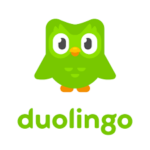
I mention Duolingo here because one of the elements that I was missing the most while using LingQ was the gamified approach, and that cute little bird is always encouraging you (some would say pestering you), but for more serious types, LingQ might feel like a better fit.
Here’s our full review of Duolingo.
LingQ vs. Drops

I figured Drops would be good to compare to LingQ because it’s also a spaced repetition vocabulary app.
Drops is more gamified-feeling than LingQ and it doesn’t feel like a holistic learning program; rather it’s a supplementary app that you can use in addition to whatever main program you’re using.
Overall, I’d choose LingQ in this match-up. You get the vocabulary plus a bunch of other stuff for about the same price.
Here’s our full review of Drops.
LingQ vs. Rosetta Stone

Rosetta Stone has those vivid photographs that really make a huge difference for me.
While Rosetta Stone teaches words and phrases in context like a native speaker would learn their own language, LingQ actually does the same thing, but with way more authentic content.
This, for me, makes LingQ more of an “adult” language learning program. You can immerse yourself in your target language while you’re learning about other things.
In this match-up, I prefer LingQ.
Here’s our full review of Rosetta Stone.
How Much Does LingQ Cost?
- The base LingQ program is free, but quite limited.
- A Premium plan with LingQ costs $12.99 a month or $107.88 for a year.
- A Premium Plus plan costs $39.99 per month or $431.88 for a year.
This plan includes live tutoring and writing correction.
Here’s a link to LingQ’s payment page.
The Final Verdict on LingQ
After exploring LingQ as a language learning program, I found a lot to love but also a lot to dislike. That begs the question: is LingQ worth it?
The answer is a cautious yes.
LingQ is arguably one of the biggest collections of authentic language learning materials, and that value to language learners is undeniable. Couple this with its built-in dictionary and flashcard features, and LingQ is a powerhouse that can help a user make meaningful progress in any of its offered languages.
Despite this, I believe that users will need to use supplementary materials in addition to LingQ to round out their language learning regimen. At a minimum, you should include opportunities for speaking and writing practice in your learning, and you should consider some sort of grammar guide or grammar practice material if you do not subscribe to LingQ’s “no grammar” mantra.
One program that you could use to supplement the language learning process is FluentU.
With FluentU, you hear languages in real-world contexts—the way that native speakers actually use them. Just a quick look will give you an idea of the variety of FluentU videos on offer:

FluentU really takes the grunt work out of learning languages, leaving you with nothing but engaging, effective and efficient learning. It’s already hand-picked the best videos for you and organized them by level and topic. All you have to do is choose any video that strikes your fancy to get started!
Each word in the interactive captions comes with a definition, audio, image, example sentences and more.
Access a complete interactive transcript of every video under the Dialogue tab, and easily review words and phrases from the video under Vocab.
You can use FluentU’s unique adaptive quizzes to learn the vocabulary and phrases from the video through fun questions and exercises. Just swipe left or right to see more examples of the word you're studying.

The program even keeps track of what you’re learning and tells you exactly when it’s time for review, giving you a 100% personalized experience.
Start using the FluentU website on your computer or tablet or, better yet, download the FluentU app from the iTunes or Google Play store. Click here to take advantage of our current sale! (Expires at the end of this month.)
So, is LingQ the best way to learn a language?
Only you can decide that for yourself.
What is clear, however, is that LingQ can be an integral part of a larger language learning plan and add tremendous progress to learners seeking fluency in a given language. Give it a try and see if it is right for you!
